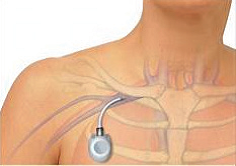Port a cath post op instructions
Download and print as a PDF
Download- What is a Port-a-Cath?
- How should I look after myself when I get home from surgery?
- When can I have a shower?
- When can I use the Port-a-Cath?
- How I do clean the Port-a-Cath?
- Should I limit my activities with a Port-a-Cath?
- When to seek help …
- Port-a-Cath usage and care
- Who can I contact for further information and support?
What is a Port-a-Cath?

How should I look after myself when I get home from surgery?
On the day of surgery, it is better to have someone to accompany you home after surgery and look after you overnight.
You can take on-shelf pain medication if needed (e.g. paracetamol or ibuprofen). Your normal medications can be taken unless otherwise directed.
You may experience some mild swelling and/or bruising in the area of the incision. It may take several days to get better.
You can remove your dressings one week after surgery.
In all cases, skin stiches are dissolvable after 10 days and you don’t have to go to your GP to take them out.
When can I have a shower?
You can take a short shower after 48 hours. The steri-strips (small white strips) on your wound will be covered by a waterproof Opsite dressing.
If the surgeon used skin glue on the incision instead of steri-strips, you can remove the dressing after 48 hours, and you can have short shower as soon as you like. The glue will flake off over the next 2-3 weeks.
In some cases, a needle can be left in situ for early use of medication (e.g. IV antibiotics) in day one after your operation. In this case, please follow the exact instructions given by the surgeon. In general, showering is not permitted until the needle is removed.
When can I use the Port-a-Cath?
The Port-a-Cath can be used normally after one week of insertion, as postoperative swelling has the potential to make access more challenging. However, in a few cases, it may be used immediately but only if a needle has been left in situ and you have been instructed by your surgeon to do so.
You may feel a small bump under the skin which is the site of the port.
How I do clean the Port-a-Cath?
When not in use, the Port-a-Cath must be flushed at least every six weeks, using heparinised saline to prevent blood clots forming inside the catheter.
You should follow the special instructions to flush out your Port-a-Cath given to you by the team looking after you.
Should I limit my activities with a Port-a-Cath?
Strenuous exercises or activities should be avoided during the first ten days.
You can wear a seatbelt, and you can drive your car, unless told otherwise by your doctor.
When to seek help …
You need to seek medical advice if one of the following appears:
- redness, tenderness and/or swelling at the site of the surgery.
- shortness of breath.
- bleeding from incision.
- fever over 38.
- chills.
- arm swelling.
- blockage or fail to inject medication (due to thrombosis).
Port-a-Cath usage and care
Is always performed by your main team looking after you.
In general, effective hand washing practice used alongside Aseptic Non-Touch Technique (ANTT) is vital in reducing the risk of infection and should be applied to all aspects of the care.
Who can I contact for further information and support?
Your follow-up will be with your referring doctor on the team that is looking after you.
If you have any questions during the first 48 to 72 hours before using the Port-a-Cath, please contact the Royal Sussex County Hospital:
Telephone: 01273 696955.
Please ask the main switchboard to transfer to the vascular registrar on call, bleep: 8004.
If you have any questions while you are using the Port-a-Cath, please contact the team looking after you.
Disclaimer
The information in this leaflet is for guidance purposes only and is in no way intended to replace professional clinical advice by a qualified practitioner.
Publication Date: February 2021
Review Date: November 2023


